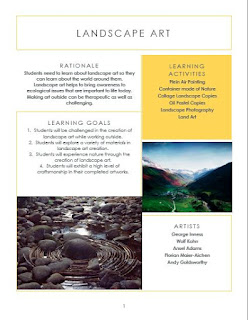Art
Tuesday, April 25, 2017
Wednesday, March 29, 2017
Sunday, March 19, 2017
Evening for Educators Workshop: Playground
James Mollison’s “Playground”
Your Classroom
is a Playground for Art
Issues:
Limited funding for art classrooms and/or schools, limited materials, how to
use non-art materials for art
Learning Goals:
1. Discuss
how art making can be fun and productive at the same time
2. Discover
how art making and learning is possible with limited materials
Questions:
1. What
memories do you have of the playground?
2. How
do playgrounds now differ from when you were a child?
3. What
is the purpose or function of a playground? Do kids learn specific skills or is
the playground only for play?
4. What
is the difference between play and work?
5. How
can you play in your classroom? How can you accomplish your learning goals
while doing so?
6. Some
of the images in the Playground exhibit show school yards without much in them,
but the children are still able to play and have fun. How can you still have good
art projects and accomplish your learning goals if you have limited materials
or funding?
7. Can
it be beneficial to your students to limit the materials they can use for a
project? How?
Project: In small groups, design a playground using only the materials given. Think about the structure
of your playground: is it purely functional or could it be a work of art that
also functions as a playground? Will your playground facilitate learning of
specific skills or is it just for play? At the end, we will go around and show off our playgrounds and discuss them.
Materials:
·
Plastic cups
·
Plastic straws
·
Paper
·
Masking tape
·
Scissors
·
Markers
Saturday, March 18, 2017
Tuesday, March 14, 2017
Monday, February 20, 2017
Week 3: Art History Lesson
Art History Lesson
Enduring Idea: Identity
Rationale: Students will explore ideas of identity as a
compilation of different traits, some that are unique, and some that are caused
by outside influences.
Artists/Artworks: Rembrandt, Monet, Matisse, DaVinci, Mondrian, Michelangelo, Van Gogh, Banksy, Chuck Close, Gursky, Robert Rauschenberg, Andy Goldsworthy, Ellsworth Kelly, Cy Twombly, and others.
Key Concepts: History, criticism, aesthetics
Essential Questions:
How have
contemporary artworks been influenced by the works of the old masters?
What are the
similarities between your two artworks? Differences?
How is your
artwork response for this assignment affected by the other two you chose?
Objectives:
Lesson: We will introduce art history and criticism by
projecting or pinning up two artworks from different time periods and
discussing them in class.
Activities:
Students will
choose two artworks, one contemporary and one from a different period, from a
list.
They will
discover the histories of both artworks and record them in their sketchbooks.
They will
practice art criticism by describing, interpreting, and judging, and comparing both
artworks by writing their findings in their sketchbooks.
They will make a
final art piece as a response to their two chosen artworks. On the critique
day, students will present their piece along with the two others and describe
how they responded to them.
Formative Assessment:
Students have
written the histories of the two artworks they chose in their sketchbooks.
Students have
written a criticism of the two artworks in their sketchbooks.
Their final
artwork draws from elements found in the two artworks they chose.
Their artwork was
completed on time for the final critique.
If a student
misses the critique, they must write a couple paragraphs about their art piece
and how it was influenced by the two artworks they chose.
Subscribe to:
Comments (Atom)





















